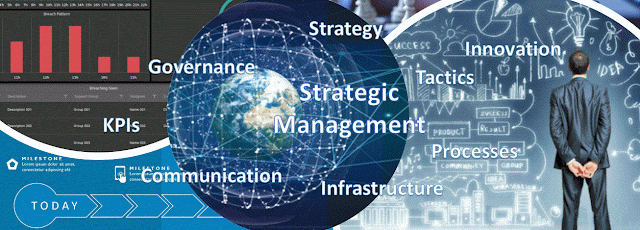 |
| Strategic Management Perspectives |
There’s an ancient parable about several blind people who touch a shape they had never met before, an elephant, and try to identify what it is. The elephant is big, more than each person can sense through direct experience, and people’s experiences don’t correlate to the degree that they don’t trust each other, the situation escalating upon case. The moral of the parable is that we tend to claim (absolute) truths based on limited, subjective experience [1], and this can easily happen in business scenarios in which each of us has a limited view of the challenges we are facing individually and as a collective.
The situation from the parable can be met in business scenarios, when we try to make sense of the challenges we are faced with, and we get only a limited perspective from the whole picture. Only open dialog and working together can get us closer to the solution! Even then, the accurate depiction might not be in sight, and we need to extrapolate the unknown further.
A third-party consultant with experience might be the right answer, at least in theory, though experience and solutions are relative. The consultant might lead us in a direction, though from this to finding the answer can be a long way that requires experimentation, a mix of tactics and strategies that change over time, more sense-making and more challenges lying ahead.
We would like a clear answer and a set of steps that lead us to the solution, though the answer is as usual, it depends! It depends on the various forces/drivers that have the biggest impact on the organization, on the context, on the organization’s goals, on the resources available directly or indirectly, on people’s capabilities, the occurrences of external factors, etc.
In many situations the smartest thing to do is to gather information, respectively perspectives from all the parties. Tools like brainstorming, SWOT/PESTLE analysis or scenario planning can help in sense-making to identify the overall picture and where the gravity point lies. For some organizations the solution will be probably a new ERP system, or the redesign of some processes, introduction of additional systems to track quality, flow of material, etc.
A new ERP system will not necessarily solve all the issues (even if that’s the expectation), and some organizations just try to design the old processes into a new context. Process redesign in some areas can be upon case a better approach, at least as primary measure. Otherwise, general initiatives focused on quality, data/information management, customer/vendor management, integrations, and the list remains open, can provide the binder/vehicle an organization needs to overcome the current challenges.
Conversely, if the ERP or other strategical systems are 10-20 years old, then there’s indeed an elephant in the room! Moreover, the elephant might be bigger than we can chew, and other challenges might lurk in its shadow(s). Everything is a matter of perspective with no apparent unique answer. Thus, finding an acceptable solution might lurk in the shadow of the broader perspective, in the cumulated knowledge of the people experiencing the issues, respectively in some external guidance. Unfortunately, the guides can be as blind as we are, making limited or no important impact.
Sometimes, all it’s needed is a leap of faith corroborated with a set of tactics or strategies kept continuously in check, redirected as they seem fit based on the knowledge accumulated and the challenges ahead. It helps to be aware of how others approached the same issues. Unfortunately, there’s no answer that works for all! In this lies the challenge, in identifying what works and makes sense for us!
Previous Post <<||>> Next Post
Resources:
[1] Wikipedia (2024) Blind men and an elephant [link]

No comments:
Post a Comment